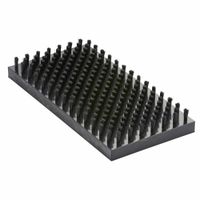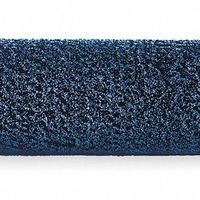Call +(254) 703 030 000 / 751 483 999 / 721 704 777
- Home
- Material Handling
- Transporting
- Conveyors Components
- Conveyor Brushes
.....Read More
Frequently Asked Questions
What are conveyor brushes used for?
Conveyor brushes are used for a variety of applications in industrial settings to enhance the efficiency and functionality of conveyor systems. They serve several key purposes:
1. **Cleaning**: Conveyor brushes are primarily used to clean conveyor belts and the materials being transported. They remove debris, dust, and residues from the belt surface, preventing contamination and ensuring a clean transport process. This is crucial in industries like food processing, pharmaceuticals, and manufacturing, where hygiene and product integrity are paramount.
2. **Product Positioning**: Brushes help in positioning and guiding products on the conveyor belt. They can gently nudge items into the correct orientation or position, ensuring they are properly aligned for subsequent processing or packaging stages.
3. **Static Removal**: In environments where static electricity can be problematic, conveyor brushes can be used to dissipate static charges. This is important in industries dealing with electronic components or materials sensitive to static discharge.
4. **Material Handling**: Brushes can assist in the handling of delicate or irregularly shaped items. They provide a soft contact surface that can move products without causing damage or deformation.
5. **Sorting and Separating**: Conveyor brushes can be used to sort and separate items based on size, shape, or other characteristics. They can help in directing different products to various paths on the conveyor system.
6. **Surface Finishing**: In some applications, brushes are used to apply a finish or texture to the surface of products as they move along the conveyor. This can be part of a manufacturing process where surface treatment is required.
Overall, conveyor brushes are versatile tools that enhance the operational efficiency of conveyor systems by maintaining cleanliness, ensuring proper product handling, and supporting various processing needs.
How do you install conveyor brushes?
1. **Identify the Type and Purpose**: Determine the type of conveyor brush needed (e.g., rotary, strip, or spiral) based on the application, such as cleaning, positioning, or sealing.
2. **Gather Tools and Materials**: Collect necessary tools like wrenches, screwdrivers, and mounting brackets. Ensure you have the correct brush size and type.
3. **Safety Precautions**: Turn off and lock out the conveyor system to prevent accidental startup. Wear appropriate personal protective equipment (PPE).
4. **Prepare the Mounting Area**: Clean the area where the brush will be installed. Ensure it is free from debris and obstructions.
5. **Install Mounting Brackets**: Attach mounting brackets to the conveyor frame. Ensure they are aligned and securely fastened.
6. **Position the Brush**: Place the brush in the desired location. For rotary brushes, ensure they are aligned with the conveyor belt. For strip brushes, position them along the edge or surface to be cleaned or sealed.
7. **Secure the Brush**: Attach the brush to the mounting brackets. For rotary brushes, ensure they are tightly secured to the shaft. For strip brushes, use screws or clips to hold them in place.
8. **Adjust Tension and Alignment**: Adjust the brush tension to ensure proper contact with the conveyor belt or surface. Check alignment to prevent uneven wear.
9. **Test the Installation**: Remove lockout devices and start the conveyor system. Observe the brush operation to ensure it functions correctly without causing damage or excessive wear.
10. **Regular Maintenance**: Schedule regular inspections to check for wear and tear. Replace brushes as needed to maintain efficiency.
11. **Documentation**: Record the installation details and maintenance schedule for future reference.
What materials are conveyor brushes made from?
Conveyor brushes are typically made from a variety of materials, each chosen for specific properties that suit different applications. The core materials for the brush backing or base can include:
1. **Wood**: Traditional and cost-effective, used for less demanding applications.
2. **Plastic**: Lightweight and resistant to moisture and chemicals, suitable for environments where hygiene is crucial.
3. **Metal**: Durable and heat-resistant, often used in heavy-duty or high-temperature applications.
The bristles or filaments of conveyor brushes are made from:
1. **Nylon**: Known for its flexibility, abrasion resistance, and ability to withstand high temperatures, making it ideal for general-purpose cleaning and material handling.
2. **Polypropylene**: Offers excellent chemical resistance and is less expensive than nylon, suitable for wet environments.
3. **Natural Fibers**: Such as horsehair or tampico, used for delicate applications where gentle brushing is required.
4. **Abrasive Nylon**: Contains grit particles for aggressive cleaning or deburring tasks.
5. **Stainless Steel**: Provides high strength and corrosion resistance, used for heavy-duty cleaning and metal surface preparation.
6. **Brass**: Softer than steel, used for non-sparking applications and to avoid scratching softer surfaces.
7. **Carbon Steel**: Offers high strength and durability for tough cleaning tasks.
The choice of materials depends on factors like the type of material being conveyed, the environment (wet, dry, hot, or cold), and the specific function of the brush (cleaning, sorting, guiding, etc.). Each material offers unique benefits that can be tailored to meet the demands of various industrial applications.
How do you choose the right conveyor brush for your application?
To choose the right conveyor brush for your application, consider the following factors:
1. **Application Purpose**: Determine the primary function of the brush, such as cleaning, sorting, guiding, or positioning. This will influence the type of brush you need.
2. **Brush Type**: Choose between strip, cylinder, or spiral brushes based on the application. Strip brushes are versatile, cylinder brushes are ideal for cleaning and moving materials, and spiral brushes are used for sorting and guiding.
3. **Bristle Material**: Select bristle material based on the material being conveyed and the environment. Common materials include nylon for general use, polypropylene for moisture resistance, and stainless steel for high-temperature or abrasive conditions.
4. **Bristle Stiffness**: Match the bristle stiffness to the application. Soft bristles are suitable for delicate surfaces, while stiff bristles are better for heavy-duty cleaning or moving.
5. **Brush Size and Density**: Consider the size and density of the brush. Larger brushes cover more area, while denser brushes provide more contact points for cleaning or moving materials.
6. **Conveyor Speed and Load**: Ensure the brush can handle the conveyor speed and load. High-speed conveyors may require more durable brushes, while heavy loads may need stiffer bristles.
7. **Environmental Conditions**: Account for environmental factors such as temperature, humidity, and exposure to chemicals. Choose materials that can withstand these conditions without degrading.
8. **Maintenance and Replacement**: Consider the ease of maintenance and replacement. Brushes that are easy to install and replace can reduce downtime and maintenance costs.
9. **Cost and Budget**: Balance the cost with the performance requirements. Higher-quality brushes may have a higher upfront cost but can offer better durability and efficiency.
By evaluating these factors, you can select a conveyor brush that meets your specific application needs effectively.
What are the benefits of using conveyor brushes?
Conveyor brushes offer several benefits in industrial and manufacturing settings:
1. **Cleaning and Maintenance**: They effectively remove debris, dust, and contaminants from conveyor belts, ensuring smooth operation and reducing downtime for maintenance.
2. **Product Handling**: Brushes provide gentle handling of products, minimizing damage and preserving product integrity, especially for delicate items.
3. **Static Reduction**: By dissipating static electricity, conveyor brushes help prevent static build-up, which can attract dust and cause operational issues.
4. **Versatility**: Available in various shapes, sizes, and materials, they can be customized to suit specific applications, including cleaning, sorting, and guiding.
5. **Cost-Effectiveness**: By maintaining conveyor efficiency and reducing the need for frequent repairs, brushes contribute to lower operational costs.
6. **Extended Equipment Life**: Regular cleaning with brushes prevents wear and tear on conveyor belts and components, extending their lifespan.
7. **Improved Safety**: By keeping conveyor systems clean and free of obstructions, brushes enhance workplace safety and reduce the risk of accidents.
8. **Efficiency**: They help maintain consistent product flow and prevent jams, improving overall production efficiency.
9. **Environmental Benefits**: Brushes can reduce the need for chemical cleaners, supporting environmentally friendly operations.
10. **Noise Reduction**: Soft brush contact can reduce noise levels compared to other cleaning methods, contributing to a quieter work environment.
How do you maintain and clean conveyor brushes?
To maintain and clean conveyor brushes, follow these steps:
1. **Regular Inspection**: Frequently check the brushes for wear and tear, ensuring bristles are intact and not excessively worn down. Replace brushes when they lose effectiveness.
2. **Cleaning Schedule**: Establish a routine cleaning schedule based on the conveyor's usage and the type of material being transported. This prevents buildup and maintains efficiency.
3. **Debris Removal**: Manually remove large debris from the brushes using a hand tool or compressed air. This prevents clogging and ensures the brushes function properly.
4. **Washing**: Use a mild detergent and water to wash the brushes. Avoid harsh chemicals that could damage the bristles. Rinse thoroughly to remove any soap residue.
5. **Drying**: Allow the brushes to air dry completely before reinstalling them. This prevents mold growth and maintains the integrity of the bristles.
6. **Lubrication**: If applicable, lubricate the brush shafts and bearings to ensure smooth operation. Use appropriate lubricants recommended by the manufacturer.
7. **Alignment Check**: Ensure the brushes are properly aligned with the conveyor belt. Misalignment can cause uneven wear and reduce cleaning efficiency.
8. **Tension Adjustment**: Adjust the tension of the brushes to maintain optimal contact with the conveyor belt. This ensures effective cleaning without causing damage.
9. **Replacement**: Replace brushes that are worn out or damaged beyond repair. Use manufacturer-recommended replacements to ensure compatibility and performance.
10. **Documentation**: Keep records of maintenance activities, including inspections, cleanings, and replacements. This helps in tracking performance and scheduling future maintenance.
By following these steps, you can ensure that conveyor brushes remain effective and extend their lifespan, contributing to the overall efficiency of the conveyor system.
Can conveyor brushes be used for non-conveyor applications?
Yes, conveyor brushes can be used for non-conveyor applications. These brushes, typically designed for cleaning, positioning, or guiding items on conveyor belts, possess versatile characteristics that make them suitable for various other uses. Their design, which often includes durable bristles made from materials like nylon, polypropylene, or natural fibers, allows them to perform effectively in different environments.
In non-conveyor applications, conveyor brushes can be used for cleaning purposes, such as removing debris or dust from surfaces in industrial settings. They can also be employed in manufacturing processes for tasks like applying coatings, spreading liquids, or smoothing surfaces. Additionally, these brushes can be adapted for use in machinery to prevent static build-up or to guide and separate items in automated systems.
Conveyor brushes can also serve in agricultural settings for cleaning produce or equipment. In the automotive industry, they might be used for cleaning parts or applying lubricants. Their adaptability extends to household applications, where they can be used for cleaning grills, gutters, or other hard-to-reach areas.
The key to using conveyor brushes in non-conveyor applications lies in selecting the appropriate brush type, size, and bristle material to match the specific requirements of the task. Customization options, such as varying the bristle density or adjusting the brush dimensions, further enhance their utility across different applications.
Overall, the versatility and durability of conveyor brushes make them a practical choice for a wide range of non-conveyor applications, provided they are appropriately adapted to the specific needs of the task at hand.



